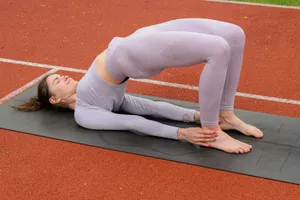How to Relieve Sciatic Pain in Buttocks
Table of Contents
- What is Sciatic Pain?
- Common Symptoms of Sciatica
- Causes of Sciatic Pain in the Buttocks
- Top 6 Methods to Relieve Sciatic Pain
- Stretching Exercises
- Strengthening Exercises
- Heat and Cold Therapy
- Over-the-Counter Pain Relievers
- Proper Posture Tips
- Lifestyle Adjustments
- When to Seek Medical Advice
- Conclusion
Sciatic pain, often referred to as sciatica, is a common issue that affects many individuals, particularly those who spend extended periods sitting or engaging in strenuous physical activity.
If you've been suffering from sciatic pain in your buttocks, you're not alone. This article will guide you through effective strategies to relieve this discomfort and improve your quality of life.
Understanding Sciatic Pain
Before diving into how to relieve sciatic pain in the buttocks, it’s essential to understand what it is. Sciatica is caused by irritation of the sciatic nerve, which runs from your lower back down through your buttocks and into your legs. Symptoms may include:
Sharp pain in the buttocks
Numbness or tingling down the leg
Weakness in the affected leg
Pain that worsens with prolonged sitting
Causes of Sciatic Pain
Sciatic pain can stem from various issues, including:
Herniated Discs: Discs that bulge or rupture can press on the sciatic nerve, causing pain.
Spinal Stenosis: Narrowing of the spinal canal can lead to nerve compression.
Piriformis Syndrome: The piriformis muscle can tighten and irritate the sciatic nerve.
Injury or Trauma: Accidents or falls can lead to sciatica.
How to Relieve Sciatic Pain in Buttocks
Now, let’s explore effective methods for relieving sciatic pain. These strategies aim to alleviate pain and improve mobility.
1. Stretching Exercises
Gentle stretching can help relieve tension in the muscles surrounding the sciatic nerve. Here are a few effective stretches:
Piriformis Stretch: Sit on the floor with your legs extended. Cross your right leg over your left and gently pull your right knee towards your left shoulder. Hold for 20-30 seconds and switch sides.
Hamstring Stretch: Lie on your back and lift one leg towards the ceiling, keeping it straight. Use a towel to gently pull the leg closer. Hold for 20-30 seconds.
Seated Forward Bend: Sit with your legs straight in front of you. Slowly bend forward from your hips, reaching towards your toes. Hold for 20-30 seconds.
2. Strengthening Exercises
Strengthening the core and glute muscles can alleviate pressure on the sciatic nerve. Consider these exercises:

Bridges: Lie on your back with knees bent. Lift your hips off the ground, forming a straight line from your shoulders to your knees. Hold for a few seconds, then lower. Repeat 10-15 times.
Bird-Dogs: On all fours, extend one arm and the opposite leg. Hold for a few seconds, then switch sides. Repeat 10 times on each side.
Side Leg Raises: Lie on your side with your legs straight. Lift the top leg while keeping it straight. Lower it back down. Repeat 10-15 times on each side.
3. Heat and Cold Therapy
Applying heat or cold can significantly reduce sciatic pain:
Cold Packs: Apply a cold pack to the affected area for 15-20 minutes to reduce inflammation.
Heat Pads: After the first 48 hours, use a heating pad to relax tight muscles and improve blood flow.
4. Over-the-Counter Pain Relievers
Non-prescription medications can help manage pain:
Ibuprofen: Helps reduce inflammation and relieve pain.
Acetaminophen: Offers pain relief without anti-inflammatory effects.
5. Maintain Good Posture
Proper posture can prevent further irritation of the sciatic nerve. Here are a few tips:
Keep your feet flat on the floor while sitting.
Use a chair with good lumbar support.
Avoid crossing your legs for extended periods.
6. Lifestyle Changes
Making a few lifestyle adjustments can reduce the risk of sciatic pain:
Stay Active: Regular low-impact activities like walking or swimming can promote spinal health.
Weight Management: Maintaining a healthy weight reduces pressure on the spine.
Ergonomic Workspace: Ensure your workspace is set up to promote good posture.
When to See a Doctor
While many cases of sciatic pain can be managed at home, it’s crucial to consult a healthcare professional if:
The pain is severe and persistent.
You experience sudden weakness in your leg.
There are changes in bowel or bladder control.
Conclusion
Relieving sciatic pain in the buttocks involves a combination of stretching, strengthening, and lifestyle changes. By incorporating these methods into your daily routine, you can alleviate pain and improve your overall mobility.
Remember, if your symptoms persist or worsen, don’t hesitate to seek professional medical advice. Take charge of your health today.
Read What Helps Sciatic Pain in the Buttocks?.
People Also Asked
- What is the fastest way to relieve sciatic pain in the buttocks?
- Using cold packs followed by heat therapy and gentle stretching can quickly reduce sciatic pain.
- Can stretching relieve sciatic pain?
- Yes, specific stretches like the piriformis and hamstring stretches are highly effective for sciatic pain relief.
- How long does sciatic pain last?
- Sciatic pain can last from a few days to several weeks, depending on the cause and treatment.
- Does poor posture worsen sciatica?
- Yes, poor posture can aggravate sciatic nerve compression, increasing pain.
- Can sciatica go away on its own?
- Mild sciatica often resolves without medical intervention in a few weeks.
- What exercises are good for sciatica?
- Low-impact exercises like walking, bird-dogs, and bridges are effective for strengthening and relieving pressure.
- What is piriformis syndrome?
- It is a condition where the piriformis muscle irritates the sciatic nerve, causing pain in the buttocks.
- Can weight loss help with sciatica?
- Yes, maintaining a healthy weight reduces spinal pressure, alleviating sciatic pain.
- Is massage therapy good for sciatica?
- Targeted massage can relieve muscle tension and reduce sciatic pain symptoms.
- What type of doctor should I see for sciatica?
- Consult a neurologist, orthopedic specialist, or physical therapist for severe or persistent sciatica.

